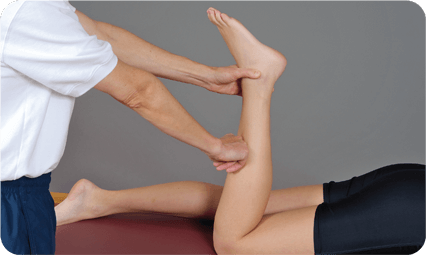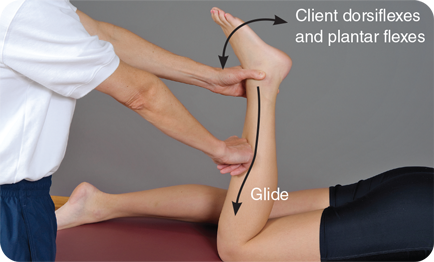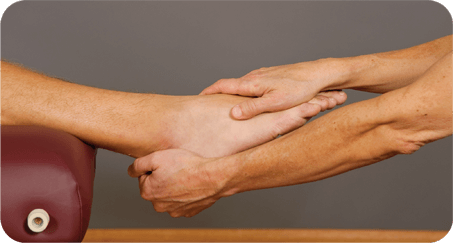Massage and soft-tissue release for shin splints
This is an excerpt from Soft Tissue Therapy for the Lower Limb by Jane Johnson.
Shin splints is a generic lay term used to describe pain on the anterior leg, commonly the result of overuse activities such as running. The therapeutic name is medial tibial stress syndrome. There is pain on the medial tibial border, and often, there is pes planus foot posture. The client may have a tight Achilles tendon, and dorsiflexion is usually restricted. Many factors may contribute to the development of this condition. Massage and stretching can be soothing.
Massage
Passively flex your client’s knee. Starting at the ankle, use your fist to massage from the ankle to the knee (figure 5.25).

Soft Tissue Release
Soft tissue release is helpful in addressing tension in the tissues of the anterior leg and may be performed with the client in the prone or supine position.
Active Assisted Gliding Soft Tissue Release for the Tibialis Anterior: Prone
With your client in the prone position, apply a small amount of a massage medium, such as oil or wax, to the front of the leg. Starting at the ankle, gently glide your fist along the length of the tibialis anterior muscle as your client actively dorsiflexes and plantar flexes the ankle (figure 5.26).

Active Assisted Soft Tissue Release for the Tibialis Anterior: Supine
To apply STR in the supine position, start by shortening the muscle. Next, apply gentle pressure to the muscle (figure 5.27a), close to its origin. Maintaining this pressure, lengthen the muscle in question by either passively or actively plantar flexing the ankle (figure 5.27b). When you have done this, select a different spot on the muscle, perhaps distal to where you first applied pressure, and repeat the process of first shortening the muscle, then applying pressure and maintaining this pressure whilst plantar flexing the ankle.

Note that in this example, a therapist experienced in the use of STR is using the elbow to gently compress the tibialis anterior. If you are unfamiliar with this technique, it is better to start by gently fixing or locking the muscle using your thumbs to avoid potentially bruising the tissues covering the shin.
TIP
It is obviously important to ensure that pain on the anterior shin is not the result of stress fractures, in which case, this technique would be contraindicated.
Stretching
Stretching is important following soft tissue release to the tibialis anterior. When treating someone for shin splints, stretching the calf muscles is also needed because of the likely restriction in this muscle group. Please see the previous sections on tight calf muscles and calf cramping.
Passive Stretches
Passive stretching of the tibialis anterior is not particularly effective, because this compresses the posterior ankle, squashing the Achilles tendon, and can be uncomfortable. However, adding slight traction as you perform the stretch can help reduce this compression and make the stretch feel more comfortable (figure 5.28).

Active Stretches
A simple active stretch is to point the toes, thus plantar flexing the foot and stretching the tibialis anterior (as in figure 5.29).

Strengthening
Strengthening of both the tibialis anterior and posterior calf muscles is crucial to recovery from shin splints, especially if your client is engaged in sporting activity or recreational fitness. Please see chapter 9 for more details.
Running Footwear and Gait
A review of the footwear the person uses when engaged in impact sports such as running is likely to be helpful, because adequate shock absorption could reduce the likelihood of reinjury. In some cases, orthotics may be useful. Use of compression stockings has also been reported to ease symptoms. If your client is a runner, referral to a specialist for analysis of their running gait could help identify whether running retraining is needed.
More Excerpts From Soft Tissue Therapy for the Lower LimbSHOP

Get the latest insights with regular newsletters, plus periodic product information and special insider offers.
JOIN NOW
Latest Posts
- Using double inclinometers to assess cervical flexion
- Trunk flexion manual muscle testing
- Using a goniometer to assess shoulder horizontal adduction
- Assessing shoulder flexion with manual muscle testing
- Sample mental health lesson plan of a skills-based approach
- Sample assessment worksheet for the skill of accessing valid and reliable resources


